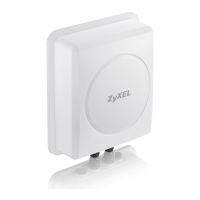Chapter 10 Firewall
LTE7410 User’s Guide
69
The following table describes the labels in this screen.
10.3 Default Action Screen
Use this screen to set the default action that the firewall takes on packets that do not match any of
the firewall rules. Click Security > Firewall > Default Action to display the following screen.
Figure 50 Security > Firewall > Default Action
The following table describes the labels in this screen.
Table 22 Security > Firewall > General
LABEL DESCRIPTION
High This setting blocks all traffic to and from the Internet. Only local network traffic and LAN to WAN
service (Telnet, FTP, HTTP, HTTPS, DNS, POP3, SMTP) is permitted.
Medium This is the recommended setting. It allows traffic to the Internet but blocks anyone from the
Internet from accessing any services on your local network.
Low This setting allows traffic to the Internet and also allows someone from the Internet to access
services on your local network. This would be used with Port Forwarding, Default Server.
Custom Use this setting to be able to create and edit individual firewall rules.
Firewall rules can be created in the Default Action screen (Section 10.3 on page 69) and Rules
screen (Section 10.4 on page 70).
Off This setting is not recommended. It disables firewall protection for your network and could
potentially expose your network to significant security risks. This option should only be used for
troubleshooting or if you intend to use another firewall in conjunction with your router.
Apply Click this to save your changes.
Cancel Click this to restore your previously saved settings.
Table 23 Security > Firewall > Default Action
LABEL DESCRIPTION
Default Action Use the drop-down list boxes to select the default action that the firewall is to take on
packets that are traveling in the selected direction and do not match any of the firewall
rules.
Select Drop to silently discard the packets without sending a TCP reset packet or an ICMP
destination-unreachable message to the sender.
Select Reject to deny the packets and send a TCP reset packet (for a TCP packet) or an
ICMP destination-unreachable message (for a UDP packet) to the sender.
Select Permit to allow the passage of the packets.

